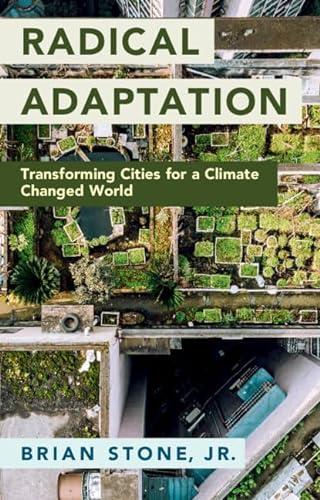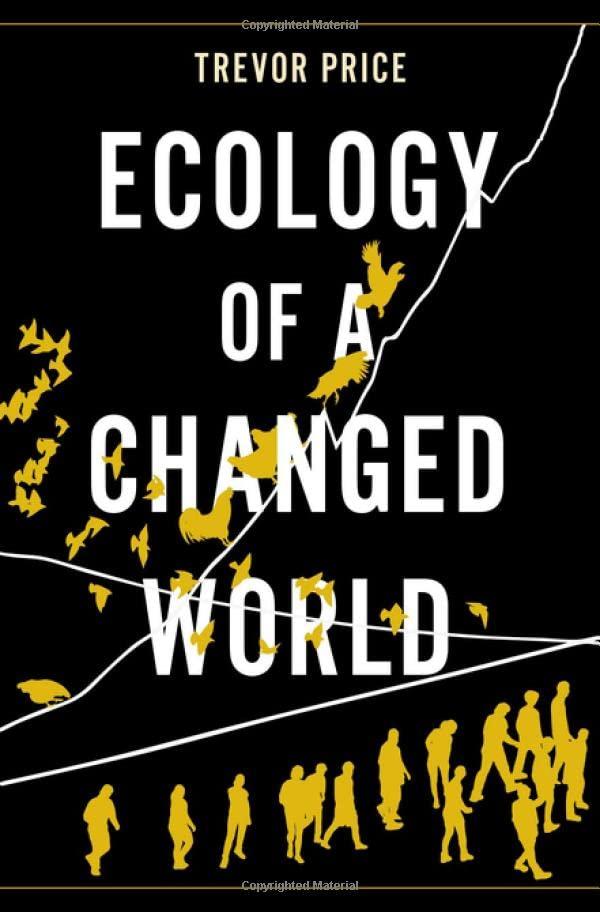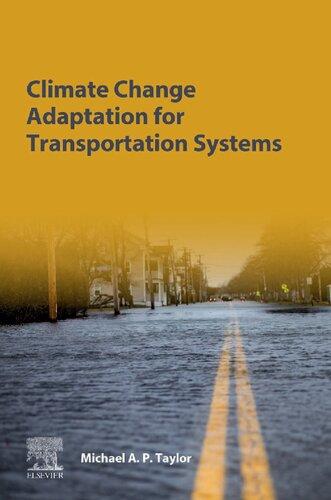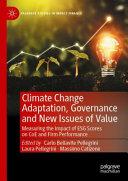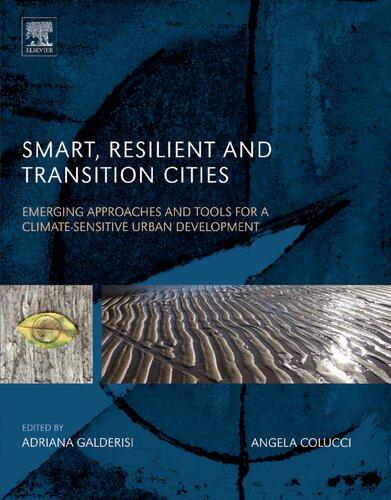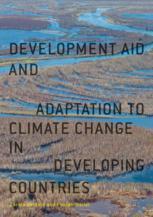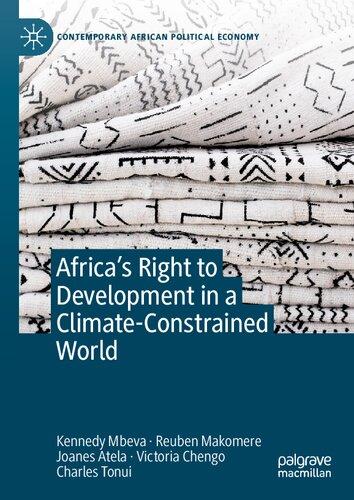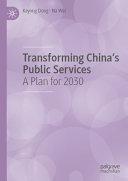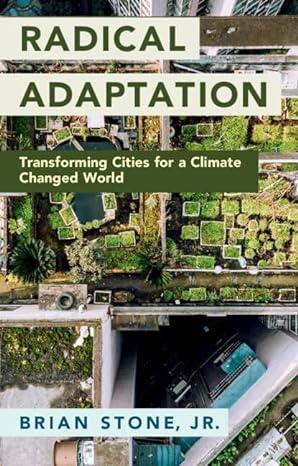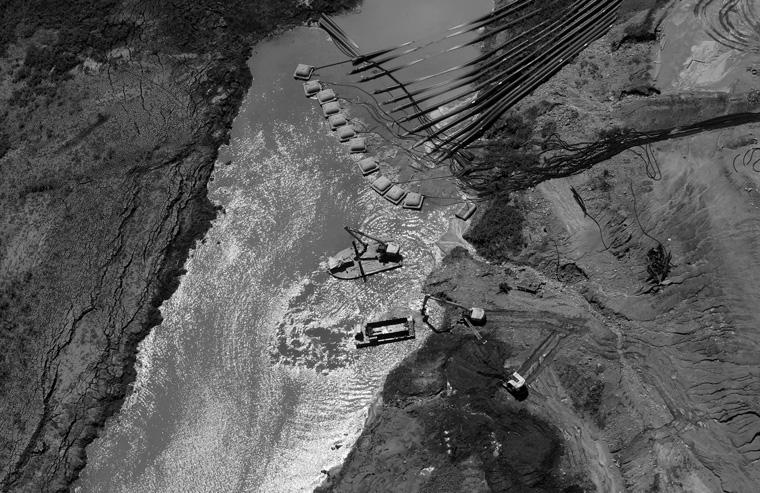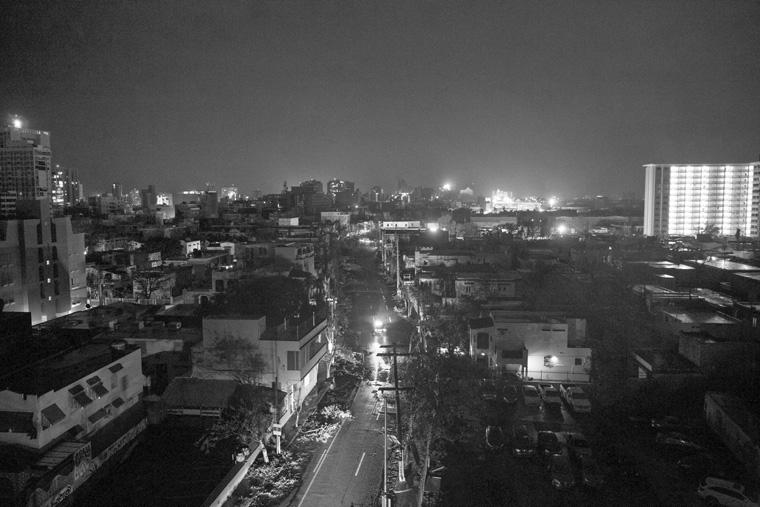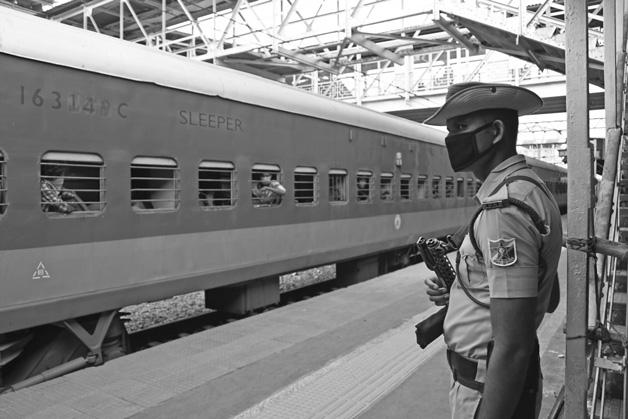Radical Adaptation: Transforming Cities for a Climate Changed World Stone Jr. Visit to download the full and correct content document: https://ebookmass.com/product/radical-adaptation-transforming-cities-for-a-climate-ch anged-world-stone-jr/
More products digital (pdf, epub, mobi) instant download maybe you interests ...
Ecology of a Changed World Trevor Price https://ebookmass.com/product/ecology-of-a-changed-world-trevorprice/
Climate Change Adaptation for Transportation Systems: Adapting for Climate Change and Extreme Weather Impacts 1st Edition Michael A.P. Taylor
https://ebookmass.com/product/climate-change-adaptation-fortransportation-systems-adapting-for-climate-change-and-extremeweather-impacts-1st-edition-michael-a-p-taylor/
Penny Dreadful and Adaptation. Reanimating and Transforming the Monster 1st Edition Julie Grossman
https://ebookmass.com/product/penny-dreadful-and-adaptationreanimating-and-transforming-the-monster-1st-edition-juliegrossman/
Climate Change Adaptation, Governance and New Issues of Value Carlo Bellavite Pellegrini
https://ebookmass.com/product/climate-change-adaptationgovernance-and-new-issues-of-value-carlo-bellavite-pellegrini/
Smart, Resilient and Transition Cities: Emerging Approaches and Tools for A Climate-Sensitive Urban Development 1st Edition
Adriana Galderisi
https://ebookmass.com/product/smart-resilient-and-transitioncities-emerging-approaches-and-tools-for-a-climate-sensitiveurban-development-1st-edition-adriana-galderisi/
Development Aid and Adaptation to Climate Change in Developing Countries 1st Edition Carola Betzold
https://ebookmass.com/product/development-aid-and-adaptation-toclimate-change-in-developing-countries-1st-edition-carolabetzold/
The World We Make: A Novel (The Great Cities #2) N. K.
Jemisin
https://ebookmass.com/product/the-world-we-make-a-novel-thegreat-cities-2-n-k-jemisin/
Africa’s Right to Development in a Climate-Constrained World Kennedy Mbeva
https://ebookmass.com/product/africas-right-to-development-in-aclimate-constrained-world-kennedy-mbeva/
Transforming China's Public Services: A Plan for 2030
Keyong Dong
https://ebookmass.com/product/transforming-chinas-publicservices-a-plan-for-2030-keyong-dong/
RadicalAdaptation Thisbookconsiderstheeverydayconduitsthroughwhichclimateinstabilityis revealingitself:thestormsewerdrainonyourstreet,thepowerlinestransportingyour electricity,themixofvegetationinyourbackyardorneighborhoodpark – thesearethe pathwaysthroughwhichclimatechangeismostlikelytoimpactyourlife.Formany, thesearethelastplacesweexpectitto.Inthisbook,Stone’saimistounderstandhow climatechangeisalteringourlivesinthepresentperiod – thisperiodoftransition betweentheancient,stableclimateofourancestorsandtheunfolding,nolongerstable climateofourchildren – andhowourcitiesmightadapttothesechanges.Stone’s concerniswiththerisksposedbyanewenvironmentalregimeforwhichourmodesof livingareill-adapted,andwithhowthesemodesoflivingmustbealtered – radically altered – topersistinaclimatechangedworld.
BrianStone,Jr.isaProfessorintheSchoolofCityandRegionalPlanningattheGeorgia InstituteofTechnology,whereheteachesurbanenvironmentalplanninganddirectsthe UrbanClimateLab.Stone’sprogramofresearchisfocusedonurbanscaledriversof climatechangeandhasbeensupportedbytheNationalScienceFoundation,USCenters forDiseaseControlandPrevention,andUSEnvironmentalProtectionAgency.Stone’s workonurbanizationandclimatechangeisregularlyfeaturedin TheNewYorkTimes, TheWashingtonPost,andon NationalPublicRadio.Heisauthorof TheCityandthe ComingClimate:ClimateChangeinthePlacesWeLive (2012,CambridgeUniversity Press),whichreceiveda Choice OutstandingAcademicTitleAward.Stoneholds degreesinenvironmentalmanagementandurbanplanningfromDukeUniversityand theGeorgiaInstituteofTechnology.
“Citiesareattheforefrontofclimatechange.ProfessorStoneprovidesacompelling accountofhowpastinfrastructurechoicesincitiesinteractwithextremeweatherand climateeventsbeingincreasinglyfueledbyclimatechangetoaffectthehealthand well-beingofresidents.Focusingonhighambienttemperatureandwater(toomuch ortoolittle),ProfessorStoneprovidesinteresting,illustrative,andevidence-based storiesofcurrentimpactsincitiesassociatedwithchangingweatherpatterns;and demonstrateshowtimely,practical,andurgentinvestmentsinre-engineering infrastructurewouldincreaseresiliencetoadditionalclimatechange.”
ProfessorKristieL.Ebi,UniversityofWashington
“RadicalAdaptation bringsaglobalperspectivetoourengagementwiththereality ofclimatechangeineverydaylife.Inthisinsightfulandcarefullyresearchedbook, Stoneexploresaseriesofemergingintersectionsbetweenclimate,infrastructure, andcontemporarycities.”
ProfessorMatthewGandy,UniversityofCambridge.
“ProfessorStonehaswrittenamagnificentlycleartextoutliningthemostcritical currentimpactsofclimatechangeoncities(heat,drought,sealevelrise,and flooding)andplausiblesolutions.Withexpertsynthesis,hepresentscomplex scientificinformationinunderstandable,jargon-lesslanguage,providingbrilliant insightintocurrentconditions,futurethreats,andadaptationoptions.Thisbookisa must-readforanyoneengagedinurbaninfrastructureandplanningandclimate adaptationandanyoneinterestedinhowclimatechangeisalteringourlives.”
ProfessorPeterJ.Marcotullio,Director,CUNYCenter forSustainableCities,HunterCollege
“Thisbookdescribesthemanywaystheclimatecrisisimpactsonusnowinour homes,neighborhoodsandlivelihoodsandthemosteffectivedoablemeasuresto addressthese.Whatmakesitspecialistheinterweavingofdetailedcitycasestudies withageneraltext(alsodetailed)andhistoricexamples.”
ProfessorDavidSatterthwaite,InternationalInstitute forEnvironmentandDevelopmentandVisiting Professor,UniversityCollege,London
“Citiesareinaconstantstateofbecoming,andnowclimatechangeisforcing societiestoevenmoredramaticallyreimaginehowcitiesarebuilt,andhowpeople liveinthem.Inresponse, RadicalAdaptation providesacompellingeye-leveland planning-basednarrativeonthepathwaysandpossibilitiesthatlieaheadforurban spacesandresidents.Asasolutions-focusedbook,itdetailsthestoryofhowpositive transformativechangeiswithinourowngrasp,andthatthecumulativeimpactof smallanddiscretesteps,evenagainstrisingchallenges,canbecometherebuilding thatisneededtocreatemoreresilient,sustainable,andequitablecommunities.”
ProfessorWilliamD.Solecki,HunterCollege,CityUniversityofNewYork
RadicalAdaptation TransformingCitiesforaClimateChangedWorld BRIANSTONE,JR. GeorgiaInstituteofTechnology
ShaftesburyRoad,CambridgeCB28EA,UnitedKingdom
OneLibertyPlaza,20thFloor,NewYork,NY10006,USA477
WilliamstownRoad,PortMelbourne,VIC3207,Australia
314–321,3rdFloor,Plot3,SplendorForum,JasolaDistrictCentre, NewDelhi – 110025,India
103PenangRoad,#05–06/07,VisioncrestCommercial,Singapore238467
CambridgeUniversityPressispartofCambridgeUniversityPress&Assessment, adepartmentoftheUniversityofCambridge.
WesharetheUniversity’smissiontocontributetosocietythroughthepursuit ofeducation,learningandresearchatthehighestinternationallevelsofexcellence.
www.cambridge.org
Informationonthistitle: www.cambridge.org/9781009211178
DOI: 10.1017/9781009211192
©BrianStone,Jr.2024
Thispublicationisincopyright.Subjecttostatutoryexceptionandtotheprovisions ofrelevantcollectivelicensingagreements,noreproductionofanypartmaytake placewithoutthewrittenpermissionofCambridgeUniversityPress&Assessment.
Firstpublished2024 AcataloguerecordforthispublicationisavailablefromtheBritishLibrary LibraryofCongressCataloging-in-PublicationData
Names:Stone,Brian,Jr.,author.
Title:Radicaladaptation:transformingcitiesforaclimatechangedworld/BrianStone,Jr., GeorgiaInstituteofTechnology.
Description:NewYork:CambridgeUniversityPress,2024.|Includesbibliographical referencesandindex.
Identifiers:LCCN2023031394|ISBN9781009211178(hardback)| ISBN9781009211154(paperback)
Subjects:LCSH:Municipalengineering.|Cityplanning – Climaticfactors.|Climatechange adaptation.|Citiesandtowns.|Urbanclimatology. Classification:LCCTD168.5.S762024|DDC628–dc23/eng/20230822
LCrecordavailableat https://lccn.loc.gov/2023031394
ISBN978-1-009-21117-8Hardback ISBN978-1-009-21115-4Paperback
CambridgeUniversityPress&Assessmenthasnoresponsibilityforthepersistence oraccuracyofURLsforexternalorthird-partyinternetwebsitesreferredtointhis publicationanddoesnotguaranteethatanycontentonsuchwebsitesis,orwillremain, accurateorappropriate.
For Josie
Acknowledgments Thisbookwasbornofanunexpectedoutcome.Interestedtounderstandthe paceofwarmingincitiesrelativetothatoftheplanetasawhole,myresearch group – theUrbanClimateLabattheGeorgiaInstituteofTechnology – carried outananalysisoftemperaturechangeinthemostpopulousUScities.The outcomeofthisstudyenabledarankingofUScitiesbasedontherateofurban warming,andthemostrapidlywarmingcitywasnotfoundtobeadesertcityor thelargestcityorthecitywiththehighestrateofpopulationgrowth.Themost rapidlywarmingcityintheUnitedStatesatthattimewasLouisville, Kentucky – amid-sizedcityinahumid-subtropicalzonewithampleaccess towater.Thereasonsforthisacceleratedwarmingtrendarevariedandrange fromapaucityoftreecanopyinthedowntowndistricttotheupwindpositioningoflarge,heat-emittingindustries.Totheimmensecreditofthecity’s leadership,ratherthanprotestorignorethisratherignominiousranking, Louisvillecommittedtocoolitselfdown.
InpartneringwiththeOfficeofSustainabilityinLouisville,inconcertwith asetoffoundationshelpingtosupportthework,theUrbanClimateLabsought toexploretheextenttowhichalargecitycouldalteritsownweather.Most critically,towhatextentwouldacitywideincreaseintreecanopyandtheuseof coolroofingmaterialsnotonlylowerneighborhoodtemperaturesbutpotentiallyreducetheannualnumberofheat-relateddeaths?Whichresidentsare mostvulnerabletotheseimpacts?Adecade-longjourneytoanswerthese questions – inLouisvilleandnumerousothercities – hasgivenrisetothe ideasinthisbook.
Iammostgratefultothearrayofone-timestudents,colleagues,planners, andforward-lookingcommunityadvocateswhohaveenabledtheresearchand experimentationinformingthisbook.ThislistincludesmostcentrallyJosh Bakin,JohnBolduc,ChristianBraneon,ChristyBrown,BumseokChun,Matt Grubisich,DanaHabeeb,DudleyHartel,MichelleKing,MariaKoetter,Kevin
Lanza,EvanMallen,TedRussell,JasonVargo,andHowardWertheimer.This workhasbenefitedgreatlyfrompartneringwithcolleaguesonaseriesof academicpapersthathaveinformedthiswork,includingthelate(andmuch missed)GodfriedAugenbroe,AshleyBroadbent,MateiGeorgescu,Santiago Grijalva,CarinaGronlund,SharonHarlan,DavidHondula,ScottKrayenhoff, LarissaLarsen,MarieO’Neill,andMayuriRajput.Mostrecently,Iam indebtedtoAtlantacitycouncilmembersLilianaBakhtiariandMatt WestmorelandfortheirsupportofclimatevulnerabilityworkinAtlanta, whichinformsthebook’sPostscript.
AsincerethankstoMattLloydandhisteamatCambridgeUniversityPress forenthusiasticallytakingonanotherunconventionalbookonclimatechange. IamfurthergratefultomycolleaguesintheSchoolofCityandRegional PlanningatGeorgiaTechwhosupportedthisbookthroughprovidingthe neededleavetimetocompleteitswriting.AspecialthankstoMichaela Masterforassistanceincompilingthebook’ssetofreferences.
Last,IamevergratefultoJosie,Wesley,William,Vivian,andOwenfor sharingmewiththiswork.Youaremyhope.
Prologue:DeadPool Inthepriorage,itwassometimesreferredtoastheSaudiArabiaofwater, anationsoamplyendowedwithfreshwater – intheformoftheEarth’smost massiveriver,sequesteredwithintheplanet’slargestexpanseofvirginrainforest,andelevatedaloftintothewindcurrentslinkinginlandjungletoocean – it rivaledtheworld’spetrostatesintermsofsheerliquidwealth.Accountingfor lessthan2percentoftheplanet’slandareabutbysomeestimates20percentof itstotalfreshwater,withnoneofitstoredinshrinkingglaciers,Brazilwasan unlikelysettingforthearmedhijackingofwatertrucks.Butmanymonthsinto adeepeningdroughtin2014,evenmilitaryescortswerefailingtoensurethe safepassageofwaterdeliveriestopartsofSãoPaulo,amegacityof21million edgingevernearertothelargestforcedevacuationinhistory[1].Asthe Paulistanoswerelearning,evenanabundanceofnaturalresourceswasno matchforanincreasinglyunnaturalclimate.
The firstresidentstoriotwereinthesuburbancityofItu.Whilecitydwellers incentralSãoPaulowereworkingtomanageperiodsofadayortwowithno flowingwaterfromtaps,thesupplyinItuwasfarlessfrequent,leavingsome residentswithoutaccesstowaterforweeksatatime[2].Manymonthsintothe nation’smostseveredroughtonrecord – withlessrainfallinginthe2014and 2015rainyseasonsthaninatypicaldryseason – regionalreservoirswere highlydepleted,insomecasesfallingto2percentofcapacity[2].Evenif sufficientpressuresremainedtopumpfromthe finalshallowsofadepleted reservoir,knownintechnicalparlanceasthe “deadpool,” thesiltyremnants wereoftentoocontaminatedfordrinking.Withnoregionalwateravailable,the onlyoptionwastotruckinwatertodistributionsites – astrategyfarunequalto demandandvulnerabletoarmedconflict.
Ofallthesocietalbenefitsprovidedbycollectivesettlementincities,clean drinkingwaterisperhapstheleastappreciatedofthemodernworld.Dating backtotheancientMinoansofCrete,whowerethe firsttotransportwaterover significantdistancesanddistributetourbansettlementsviaaqueducts,urban waterdeliverysystems – nowcoupledwithwastewaterremoval – remainthe
mostfundamentaltechnologyofcities[3].Whilelocalstorageofsolidwaste enablestrashremovalincitiestooperateonaweeklyorbiweeklyschedule,and millionsofcitydwellerseventodaylivewithoutaccesstoelectricity,nowhere intheworldcanalargepopulationbesustainedformorethanafewdays withoutaccesstopotablewater.Inperiodswithoutit,allotherhumanconcerns becomesecondary.
Paulistanosarenotabletodrawdrinkingwaterfromthesizableriversthat flowdirectlythroughtheircity.WithfewprohibitionsonwhatcanbedischargedintotheTieteandPinheirosrivers,rankedamongthemostpolluted waterwaysintheworld,everyconceivablebyproductofanindustrialmegacity isentrainedintheir flow.Intotal,anestimated4millionresidentsofSãoPaulo lackaccesstobasicsanitarysewagesystems,withmostofthishumanwaste findingitswaytotherivers.SocompleteisthedegradationoftheTieteand Pinheirosthatsubsurfaceblockagestostormwaterpipescanonlyberemoved bydiversinfullyenclosed,deep-seadivingsuits.Thebountyofsuchdives readsasthoughdrawnfromthepagesofashopwornnovel:discardedgunsand knives,asuitcase filledwithcash,adismemberedbody[4].
So,thecitymustlookelsewhereforaviablesourceofdrinkingwater. Developedinthe1960s,theintendedsolutionwasachainoflargereservoirs tothenorthknownastheCantareiraSystem.Designedtomeetthepopulation growthprojectionsofthatera,andcalibratedtorainfallpatternsoftheearlier, stableclimate,thereservoirsystem,whileamongtheworld’smostextensive, hasincreasinglyfailedtoprovideanadequatereserveofwaterforSãoPaulo (FigureP.1).By2014,lowerthanexpectedrainfallfromasinglerainyseason wassufficienttobringthewatersupplyforacityof21millioninhabitants within100daysofdepletion[5].
Rainfall,ofcourse,isonlyoneofseveralvariablesthatgovernthelifeof acity’swatersupply.Therateatwhichwateriswithdrawnfromareservoiris equallydeterminativeofhowmanydaysofdrinkingwaterremainand,onthis frontatleast,SãoPauloseemedtoholdasalvageablehand.Themostpromisingcardtoplaywasareductionintherateofregionalwaterwithdrawalsfor agriculturalandindustrialuses,estimatedatthetimetoaccountformorethan 90percentofthetotalwaterusageinthestateofSãoPaulo[6].Thisstatistic aloneisworthconsidering:Lessthanatenthofthedrinkingwatersystem constructedtosupporttheworld’sfourthlargestcitywasusedtoaddressthe waterneedsofthecity’sresidents,withtheremainder flowingtoagricultural uses(muchoftheharvestdestinedforexport),manufacturing,andpower plants.The firstwaterrationingtooccur,however,wouldnotbeinanindustrial zonebutinoutlyingresidentialneighborhoodsofthemetropolitanregion,and itwouldcomewithoutwarning.
Asecondlevertopullwhenconfrontedwithamountingwatershortageis thereductioninwaterlossesfromthevastnetworkoftunnelsandpipes deliveringwaterfromthereservoirtothetap.Whileallmajorurbanwater systemssufferfromunintendedleakage,SãoPauloexcelsinthisarea,with almost40percentofthewaterthatisstoredandtreatedlosttofailuresinthe subterraneandistributionsystem[7].Hereagain,amomentofreflectionseems warranted:Morethanathirdofthevastquantitiesofwatercollectedandstored intheSouthAmerica’slargestwatersystem – asystemthatrequiresprodigious amountsofenergytotreatanddeliverdrinkingwater – nevermakesittoatap orahoseoranirrigationsystem.SãoPaulolosesdailyaquantityofwaterthat wouldmeetthetotaldemandofallbutthelargestcitiesinNorthAmerica.An emergencycampaigntoidentifyandrepairthelargestofthesesystemfailures couldhavemeasurablyextendedthelifeofthedwindlingreservoirsystembut wasnotundertakenduringthecrisis.
Withtwoviableoptionstoextendthelifeoftheregion’sreservoirs,stateand localofficialsdecidedonathirdcourseofaction:anunannouncedrationingof waterthatwouldmostseverelyimpactthepoorestresidentsofthecity. Referredtoas “hiddenrationing,” thewaterutilitysubstantiallylowered waterpressureinthesystem,initiallyatnightbutlaterfordaysatatime,
FigureP.1PumpingwaterfromthedeadpoolintheCantareirareservoirsystem, February2015.PauloWhitaker/Reuters.
whichzeroedoutwateraccessentirelyforresidentsatthefurthestreachesof thedistributionsystemwhere,typically,thepoorestfamiliesreside[8].As neitherthewaterutilitynorlocalorregionalgovernmentofficialsacknowledgedthisdecision,and,infact,regularlydeniedit,thereisnobasistoassess theirreasoning.Butonevariableseemslikelytohaveplayedarole:The deepestdroughtinBrazil’shistoryhadarrivedontheeveofthe2014World Cup,withtheopeningmatchtobeplayedinSãoPauloonlyamonthafterthe firsttapsrandry.
The firsttotaketothestreetswerewomen.Disproportionatelyresponsible forhouseholdlabor,womenwerebearingthebruntofthewatercrisis.Fromthe vantageofcontinuously flowinghouseholdwater,itiseasytooverlookthe tremendouseffortrequiredtolocate,gather,transport,andstorewaterfordaily use.Forstarters,informationonwherewatercanbeobtained – fromanewly drilledwellorwatertankertruck – wasinfrequentandunreliable,giventhe government’sreluctancetobroadcasttheshortage.So,tripstogatherwater typicallyincludedalongwaitinlinewithlittleguaranteeofsufficientsupplies to fillavessel.Ifasourceissecured,waterranksamongtheheaviestliquids foundinnature(waterisheavierthancrudeoil,forexample),greatlylimiting thequantitythatcanbetransportedoveranymeasurabledistance.Last,few householdsservedbyamunicipaldrinkingwatersystemhavewaterstorage capacityavailable,resultingintheneedforcontinuoustripstocollectionsites.
Butadditionallaborisonlythebeginningofhowahouseholdmustadaptto limitedwater – equallyimportantishowthewaterisused.Womentendtobe the firsttorationtheirownconsumption,astheyprioritizescarcedrinking waterforchildrenandotherfamilymembers.Theresultformanywomenin poorerareasofSãoPaulo,where flowingwaterwasceasingfordaysatatime, wasachronicstateofdehydration.Soontofollowwasasharpincreasein urinarytractinfections,asthepassageofwaterthroughdigestivesystemsis essentialtothe flushingofbacteria.Forothers,moreseveregastrointestinal illnessesweretiedtotheconsumptionofcontaminatedwaterfromhastily drilledwells[9].
Ithasbeenobservedthatinperiodsofcatastrophicweather,suchasinthe aftermathofahurricaneorwildfire,communitiescometogether.Butinperiods ofresourcedepletion,suchasafamineordrought,communitiescomeapart. ManyweeksintoseverewaterrationinginSãoPaulo,water-starvedcommunitieswerecomingapart.Consistentlyassuredbylocalpoliticiansthatthere wasnowatershortage,thatstepswerebeingtakentoensureasteadydelivery ofdrinkingwaterthroughoutthedrought – evenasnowater flowedfrom householdtapsfordaysrunning – residentswhohadformonthsexhibited resiliencebegantoviewthecrisisasmuchasaninstanceofgovernmental
Prologue:DeadPool failurethanasanextremeweatherevent.Aswithallriots,theBrazilianwater riotswerebornnotjustofacrisisbutofafailinggovernmentalresponseto crisis.
Footagefromtheinitialprotestsshowfamiliaractionsofcivilresistance –marcherswithsignsandbanners,womensittinginstreetstodisrupttraffic, apolicepresenceontheperiphery.Withlittlegovernmentalacknowledgment ofwhatwerebecomingdailyprotests,moreaggressivetacticsensue.Streetsare barricadedandthenthebarricadessetafire.Rocksarehurledatpublicbuildings. Andthepolice,nowinfullriotgear, fireteargastodispersethecrowds.Soonto followisthelootingofstoresinsearchofbottledwaterandtheultimatearmed hijackingofwatertrucks[2].Lessthansixmonthsfromtheofficialdeclaration ofadrought,thelargestcityinBrazilandaglobalmodelofrapidmodernization forthedevelopingworldhadlostthecapacitytodeliverwatertoitspopulation. Beyondthereachofmoderntechnology,globallyavailablecapital,orhuman ingenuity,thesystemhadfailedtoprovideitsmostbasicandancientingredient: theregularreturnofrain.
Severalyearsafterthedrought,in2018,thenewlyelectedpresidentofBrazil wouldproclaimanintenttoacceleratedevelopmentoftheAmazon.Elevated topoweronapoliticalplatformemphasizingfurtherglobalintegrationofthe Brazilianeconomyandthepromiseofcontinuedrisingstandardsofliving, PresidentJairBolsonarosoughttorelaxa suiteofrainforestprotectionsputin placeoverthepriordecade[10 ].Alarmedbytheincreasinglyrapidrateof deforestationintheAmazonoverthe1990s,aperiodinwhichseveral hectaresofforestwerebeingcleared everyhour,earliergovernmentshad putinplacereformsthatreducedtherateofdeforestationbyanestimated 70percentbetween2005and2014 – atrendthatwouldsharplyreverseunder Bolsonaro[ 11].
WithlimitedroadsconstructedintotheinterioroftheremainingAmazon –astillvastareathesizeofAustraliaandlargelypopulatedbyIndigenous groups – illegalloggerstransportlong-bladechainsawsviamotorcycles alongcircuitousnetworksoffootpaths.Thedirectproductoftheclearcuttingcancarrysignificantvalue,butlittleifanyofthefelledwoodfrom theAmazon’sinteriorwillmakeitoutofthejungle.Withnoviableroutefor transport,theclearedforesttractsaresimplyburnedon-site,extinguishingin theprocessanunknowableextentofanimallifeandreleasingvastquantitiesof storedcarbontofurtherwarmtheatmosphere.Theintendedexportofthe illegalbutincreasinglysanctionedlogginginBrazilisnotwoodbutbeef, withtheplanet’smostessentialandteemingecosystemrapidlydegradedto anear-silentmonocultureofgrazingcattle[10].
Theprocessofconvertingrainforesttobeefisamongthemostcelebratedin theannalsofecologicalmismanagement.Forateachstepinthisprocess, energyiswasted.Theamountofsolarenergythatcanbeconvertedbythe rainforestintoedibleplants,suchasjackfruit,totakeoneexample,ismuch greaterthantheenergythatcanbeconvertedintoplantproteinintheformof grass.Asaresult,therainforest-for-pasturelandtradeoffyieldslessusable energyforhumans,asthereissimplyfarlessbiomassinanacreofgrass thaninanacreofdenseandmultilayeredrainforest.
Wereitpossibleforhumanstoconsumethepastureland’sgrassdirectly,we wouldneedaboutthreeacresofpasturetoprovideanequivalentamountofcaloric energyasfoundinasingleacreofrainforest.Putanotherway,weloseabouttwothirdsoftheavailablecaloricenergywhenweconvertrainforesttopasture[12].
Yetitisthenextstepintheprocess – theconversionofgrasstobeef – thatreally distinguishesAmazoniancattleranching.Cowsmaybetheleastefficientmachine yetconceivedbynatureandindustryfortheconversionofbiomasstoanimal protein,assomuchoftheenergycontentofthegrassisneededsimplytopropel theanimal’sdailywanderings.If66ofthe100unitsofpotentialsolar-derived caloricenergyarelostinconvertingrainforesttopastureland,roughlyanother32 unitsarelostinconvertingpasturelandtobeef[13].So,tosumupthemath,about 2percentofthecaloricenergycapturedbyanacreofrainforestcanbeconverted intocowmusclethroughdeforestation – 98percentofthecapturedsolarenergyis lost.Thesenumbersareborneoutbytheaveragedensityofcattleranchinginthe Amazontoday,withabout2.5acresofgrazinglandrequiredtosustainasingle cow – enoughland,ifplantedincrops,tofeedafamilyyear-round[14].
Vegansdelightinhighlightingtheimmenseecologicalcostsofmeatproduction,withoneanalysis findingtheconsumptionofasingleBrazilian hamburgertocarrythecarbonfootprintofa200-mileroadtrip[15].Butan additionaldimensionofAmazonianmismanagementisoftenomittedfrom meat-shamingcomputations:Therainforestisnotsimplythebeneficiaryof plentifulrain;itisitselfareservoirfromwhichtherainwaterisdrawn.Andthe reservoirismassive,withpartsoftheAmazonreceivingmorethan400inches ofraineachyear(theUnitedStates,bycomparison,averages30inchesofrain peryear)[16].Thecombinationofsaturatedsoilsandintensesolargaindueto theforest’sequatoriallocationtranslatesintosomeofthehighestlevelsof evapotranspiration(theevaporationofsurfacewaterplusthereleaseofwater vaporfromgreenplants)measuredonEarth.Thisinvisible,risingriverof watervaporgeneratescloudsacrosstheAmazonandthroughoutmuchof southeasternBrazil,alargelyself-containedhydrologiccyclethroughwhich theforestseedsitsownrainand,ultimately,therainfallreceivedbyurbanareas downwind.
Cattlegrazingrequiresextensivegrasslandstosupportit,anditequally requiresrain.ThechallengemovingforwardforAmazoniancattleranchers isthattheprovisionofthe firstinputdirectlydiminishesthesecond.Witheach acreofrainforestfelledtoclearmorelandforgrazing,thereservoirofmoisture thatdrivestheregionalhydrologicalcycleis,muchlikeanaquifer,drawn down.Theimpactofthisdrawdownisaregionalclimatethatisbecoming warmeranddrierovertime,withlessrainfallingtodaythanseveraldecades ago.Climatemodelsconsistentlyshowthatcontinueddestructionofthe Amazonianrainforestwillfurtherdiminishrainfallovertime,substantially undersomescenarios[17].Andso,thedirectconnectionbetweentheareaof rainforestandpatternsofregionalrainfallpresentsacleardilemmatoBrazilian leaders.Tosustainitself,Amazonianpasturelandrequireswhatremainsofthe rainforestfornaturalirrigation.Thesameistrueforthecity.
WhilethedriversofthedeepestBraziliandroughtonrecordaredifficultto quantifywithanyprecision – inadditiontoagradualdryingoftheAmazonan activeElNiñocycleisthoughttohaveplayedarole – theimplicationsforthe entiretyoftheSãoPaulopopulationweregrowingevermoreacutebyearly 2015.Withlessthanhalfofthetypicalrainfalloccurringinthe2014rainy season,thesubsequentrainyseasonalsofellshortofhistoricalaverages, yieldinglittlerechargeoftheregion’sdepletedreservoirs.Afewmonthsinto 2015,therationingofwaterthathadprincipallyimpactedouter-lyingareasof SãoPaulowasexpandedtothemostheavilypopulatedzones,resultinginno flowingwaterfordaysatatime.ThewaterutilityproposedinFebruary arationingsystemunlikeanypreviouslyseeninamajorglobalcity:Without thereturnofregularrainfall,nowaterwould flowtothecity’shomesfor five dayseachweek[18].
Asthefrequencyofextremeweathereventsiscreatingevermoreprolonged breakdownsinthecriticalinfrastructureoflargecities,familiarpatternsof urbanlifearealteredinrespectsbothprofoundandmundane.Stilllacking electricalpowerseveralweeksafterHurricaneMaria,in2017,SanJuan,Puerto Ricohadallbutvanishedfromnighttimesatelliteimagery,withnopowerto operatestreetlightsandtheotherinnumerablesourcesofilluminationacross adenselysettledarea(FigureP.2).Butwhatwasmostarrestingaboutthe strickencity,accordingtothosewhovisitedatthetime,wasnottheabsenceof lightbuttheeerie,deeplyunsettlingsilenceofamajormetropolisrendered inoperable.Inasimilarsense,whatmostclearlyforetellstheadvanceof awildfireintoanurbanareaisnottheblaringofsirensorthebeatingof helicopterbladesbutasoundless,light-alteringhazeinthesky,increasingly intenseandoddlybeautiful.
Forthecitywithoutwater,whatmostcharacterizestheurbanlandscapeis neitherasilencingofthestreetsnoranalteringoftheskies.Whatmost characterizesacitywithoutwateristheubiquitous,unrelentingodorof humanwaste.Manymonthsintothedeepestwatercrisistoconfrontacityof morethan10millionresidents,Paulistanoswereleftwithlittlechoicebutto triagethedwindlingquantitiesofwateravailable.Thelion’ssharewouldbe reservedfordrinkingandcooking,withsomeremainingforthewashingof handsandfaces – orperhapsthesoakingoflongunwashedclothes.Loweron thelist,dueasmuchtothelargequantityrequiredastotheperceivedimperative,wasthe flushingoftoilets.
Formany,itwasthisstenchmorethanascarcityofdrinkingwaterthatwas themoststartlingaspectofthecrisis.Whilenourishmentcouldbefoundfor mostintheformofbottledorstoredwater,aninabilitytobatheoneselfor flush awaywastewasperhapsmostrevealingofthemountingvulnerabilityofurban lifeinaclimatechangedworld.Eventhemostbasicofurbanservices – the provisionofshelter,water,andwasteremoval – couldnotberelieduponinan unstableclimate.Asobservedbyonepublicofficial, “Waterisabouthuman dignity ... Whenpeoplecannolongerwashthemselvesorusethetoiletortake careoftheirchildren,theystarttopanic” [19].
FigureP.2BlackoutinSanJuan,PuertoRicointheaftermathofHurricaneMaria, September20,2017.AlexWroblewski/GettyImages.
Compoundingthispanicwastheregularonsetofblackouts.Endowed withsuchanabundanceoffreshwater,Brazilhasextensivelydammedmany ofitslargeriversfortheproductionofhydropower,accountingformore than80percentofthecountry’selectricitygeneration[20 ].Asreservoir levelsdropped,thecapacityforhydropowerstationstoproduceelectricity wasalsodiminished,creatingdisruptionsintheelectricalgrid.With adeepeningdrought,evencoalorgas-firedpowerplantsareimpacted, duetotheirrelianceonriverorlakewaterforthecoolingofboilers, whichfurtherunderminestheresilienc eofanelectricalgridduringperiods ofwaterscarcity.Water,inthissense,isnotsimplyoneofseveralelements thatsustainsurbanpopulations;itisthecentralelement.Withoutit,thecity quicklyrevertstoapre industrialcondition – aconditionthatwasnever contemplatedformillionsofinhabitants.
Formostreadingthesepages,theexperienceofablackoutorawatermain break,leavingonewithoutpowerorrunningwater,isfamiliar.Fewerlikely haveexperiencedinamajorcitybothconditionssimultaneouslyand,ifso,for morethanadayortwo.Perhapsmorethananyotherthreatwecanimagine fromaworldwitherraticweather,includingtheviolenceofanintensehurricaneorwildfire,thefailureofcriticalinfrastructuresystemsinurbanareasis notonlyfarmoreprobableinthecomingyearsbutitisarguablymore dangerous,foritcarrieswithitthebreakdownofcivicorder.
Theconeofaforecastedhurricanetrackisknowninadvance;itspathof devastationestablishedandunchangingoncethestormhaspassed.Inthe aftermathofanacuteweatherevent,governmentsareenabledtotakeaction, implementaplantorebuild,andprojectasenseofciviccontrol.Thesameis nottrueforadrought-inducedinfrastructurefailure,whichlackseasilyimplementablesolutionsoracertaintimetable.Atwhatpointshouldamegacityof 21millioninhabitantsbeevacuatedand,ifevenpossible,wherewouldthe populationbesent?Intheearlymonthsof2015,SãoPaulowasexperiencing notonlyanecologicalcollapsebutacollapseintheveneerofsocialcontrolthat isasfundamentaltotheoperationofcitiesasdrinkingwaterandwaste removal.ForPaulistanos,theclimatecrisishadarrivednotintheformof aviolentstormsurgebutasarevelationofinstitutionalincapacity.
Unabletoresolveacrisisrootedinbothlong-termenvironmentaland infrastructuremismanagement,atthelocalandglobalscales,governmental officialspreparedfortheonlycrisisforwhichactionwaspossible:therioting ofitsownpopulation.Asdescribedcandidlybyoneofficial:
Weweredesperate.Thereservoirlevelwasjustgoingdownanddown.Weknewthat whenpeopledon’thavewater,theygocrazy.Wehadseentheprotestsinsmaller
citieswherepeoplewerebreakingintopropertytostealwater.Weimaginedwhat theywouldbelikeherewith21millionpeople.Wethoughtaboutthehospitals unabletotreatpatientsandchildrenhavingtostayhomefromschool.Itwouldbe chaos[21].
The firstprioritywasensuringthecontinuingfunctionofcriticalinstitutions –buildingsnolessdependentonwaterforoperationthanresidentialzones.To ensurecontinuedwaterdelivery,utilityworkersconstructedanew,parallel distributionsystemdirectlyconnectingtoemergencywaterreservesthe500 mostimportantbuildingsacrossSãoPaulo.Largehospitals,criticalgovernmentalbuildings,policestations,andprisonswerealltoreceivecontinuingwater supplies,evenastherestofthecityrandry.Theremainderofthecity’sresidents wouldneedtorelyonthelimitedwaterthatcouldbesuppliedviatankertruck.
Anotherofthesebuildingswasanewlyconstructedemergencyoperations center.Suchacenterwasalreadyinplace,butitslocationwaspubliclyknown. Initiallyintendedtodirectpreparationsandrecoveryoperationsfornatural disasters,thefocusoftheemergencyoperationscenterhadchangedentirely, withthepopulationtobesafeguardedfromdangerhavingnowbecomethe danger.MembersoftheBrazilianintelligenceserviceswerequietly flownto theUnitedStatestotrainalongsideSpecialWeaponsandTactics(SWAT) paramilitaryunitsandreturnedwithanewlycontracted fleetofmilitaryassault vehicles[19].Plansweremadeforaforcedevacuation[22].
WhatwasstartingtounfoldinSãoPaulointheearlymonthsof2015,asthe tapsrandryformillionsuponmillionsofresidentswhohadnotbeen adequatelyapprisedofthedepthofthecrisis,oroftheimpotenceoftheir governmentinthefaceofit,wassomethingasofyetunseeninthemodernera ofhumansettlement:thestageddepopulationofacitythatremainsphysically intact.Whilethewaterutilitywouldmanagetodeliveranabsoluteminimum quantityofdrinkingwatertoamajorityofresidentsuntilthereturnofrain, resuminglaterintheyear,thestepsundertakenbythegovernmentinpreparing forwidespreadriotingandaforcedevacuation – theonlyadministrativelevers lefttopull – attesttotheinarguablerealityconfrontedtodaybycitiesacrossthe planet:Large-scaleurbanizationisonlypossibleinastableclimate.Withoutit, theprincipalpromiseofacity – tomakeitsresidentslessvulnerabletohunger, disease,crime,andignorance – isunkept,servingtodiminishratherthanto enhancehumanwelfare.
Anditisthebeliefinthispromise,stillretainedbymuchofthemodern world,thathassustainedcitiesuntilthepresentmoment.
Thisisabookabouttransformation.Withtheworkingsoftheglobalclimate moreresponsivetohumanactivitythanatanytimeinthepast,notonlyisan
unrelentingtrendtowardhotterandunstableweathermorepredictablebutso tooisthedirectionofhumanhistory.Perhapsatnotimeinthepasthavethe crisestoconfronthumanityyearsintothefuturebeenmoreapparent,more clearlymappable,thanatthepresentmoment.Ifthisstatementistrue,thenitis reasonabletoexpectthattheseedsofthesecriseshavebeguntotakeroot amongusandareforthe firsttimevisibletothenakedeye.Itisthetransition fromoneenvironmentalregimetoanother – ashoulderseasonbetween yesterday’sclimateandtomorrow’s – thatmostclearlydescribesourpresent realityandannouncesthechangestocome.
Althoughwellunderway,thetransitionbetweentheoldenvironmentalregime andnewoperatesontwoverydifferenttimescales.Atthescaleofplanetary change,ourhuman-enhancedgreenhouseeffectisalteringthebiophysicalcompositionoftheEarthatapaceunprecedentedinthepaleoclimaticrecord.When plottedovergeologictime,therateatwhichcarbondioxideisaccumulatingin theatmosphere,pairedwithcarbonicacidintheglobaloceans,assumesthe shapeofaverticalline – theonlysuchverticalityinmorethan10millionyearsof reconstructedtrends.ChristenedtheSixthMassExtinction,therateofspecies lossunfoldingaroundusisonparwithprehistoricmeteorstrikesandperiodsof violent,sun-blockingvolcanism,withthree-quartersoftheplanet’sanimal species – representinguntoldmillionsofyearsofevolution – presentlydisappearingoverthecourseofasinglehumanlifetime.
Viewedfromthewindowofthoselivingtoday,however,thesechangescan appeargradual.Yes,thespring flowersarebloomingearlierthaninone’syouth, butaseasonalshiftofafewweeksishardlysignificantovertheperiodof a fifty-two-weekyear,evenifwearethe firsthumangenerationtoobserveit. Tetheredtoanexperientialtimelinetypicallyreachingonlyfromourgrandparentstoourgrandchildren,itistheperiodoverwhichourbodiesage,our childrengrow,andourculturalartifactspersistthatmostdirectlyframesour temporalvantage – asetofwaypointstoofewtomapthepaceofplanetary change.Ofallthethreatsposedbyachangingclimatethisisperhapsthemost pernicious:Theunprecedentedrateatwhichtheplanetischanginghas remainedjustoutsideofourbiologicalcapacitytodetectit.Butthisis changing.
Throughouttheentiretyoftheplanet’shistory,adiscontinuitybetweenthe paceofenvironmentalchangeandthecapacityofEarth’sorganismstoperceive itwasoflittleconsequence,asnosinglespecieswasinapositiontoalterthe compositionoftheatmosphereorthevolumeoftheoceans.Withthisecologicallawnolongerineffect,thecapacityforhumanstorecognizetheir impactontheglobalenvironmenthasassumedexistentialsignificanceforall species.Ill-equippedbyevolutiontorespondtoslowmovingthreats,we
requireanonexperientialmodeofdetectiontobetteralignthepaceofplanetary changewithourperceptionofit.Themodeofdetectionwehavefashionedfor thispurposeis science.
Butourscienceisfailingusinthearenaofclimatechange.Wellconstructed tolookbeyondournarrowtemporalvantage – bothbackwardandforwardin time – thescientificmethodislesswellsuitedtothepurposeofrapidsocietal change.Therulesofempiricismfoundationaltoscience – itsneedforextensive datacollectionandreproducibility – requiretimetosatisfy.Thelargerthe phenomenon,suchastheworkingsoftheglobalclimate,themoretimeis neededfortestingandvalidation,andthefurtheralongtheclimatechange trajectoryweadvance.
Equallyproblematicisthatthescientificmethodissilentonthequestionof howitsadvancementsaretobecommunicatedbeyondasmallcommunityof specialists.Rigidinitsformulafortheproductionofnewknowledge,science providesfewinsightsfortheessentialtaskofknowledgetranslation.Thistask isleftuptonewsoutlets,advocacygroups,politicians,and,increasingly,our socialmediaaccounts.Thisisaproblem.
Withnouniformlyacceptedmechanismforsocietaltranslation,thejourney fromscientificcertaintytopopularunderstandingisoftenunscripted – particularlywhenconfrontedwithwellmanagedandfundedmisinformationcampaigns.Whilepriorpublichealthbattles,suchasthatovertobaccouse,have yieldedinsightsintoeffectiveriskcommunication,suchepisodeshavebeenno lessinstructiveinthedarkartsofpublicdeception.Wehaveyetasasocietyto concludethatwillful,premeditatedmisinformationcampaignsthatcontribute tolossoflifeonparwithmilitaryconflictsorpandemicsaredeservingof criminalsanctions,orevensocialopprobrium.
Whilecontemporarydebatesoverclimatechangehaverenderedthephenomenoncomplexand,tosomedegree,exoticintheeyesofthegeneralpublic, itisneither.Relentlesslycharacterizedasunfoldinginarenasdistantfromour everydayexperience – thedisappearingicecaps,themeltingtundra,anunprecedentedheatwaveonanothercontinent – theimpactsofclimatechangemost threateningtothemajorityoftheglobalpopulationarepresentlyplayingoutin ourowncitiesandneighborhoods.Thestormsewerdrainonyourstreet,the powerlinestransportingyourelectricity,themixofvegetationandwildlifein yourbackyard – thesearetheconduitsthroughwhichclimatechangeismost likelytoimpactyourlife.Formany,thesearelastplacesweexpectitto.
Inthisbook,myaimistounderstandhowclimatechangeisalteringourlives inthepresentperiod – thisperiodoftransitionbetweentheancient,stable climateofourancestorsandtheunfolding,nolongerstableclimateofour children – andhowourcitiesmightadapttothesechanges.Myconcerniswith
Prologue:DeadPool therisksposedbyanewenvironmentalregimeforwhichourmodesofliving areill-adaptedandwithhowthesemodesoflivingmustbealtered – radically altered – topersistinaclimatechangedworld.
Myuseoftheword “radical” inthisbookhasamorespecificmeaningthanin popularusage.Rootedinthegeneralpreceptsof radicalplanningtheory [23,24,25,26,27] – anorientationtocollectivedecision-makingandaction thatoperatesoutsideofestablishedgoverninginstitutions – theideaofradical adaptationrecognizesthatestablishedmodesofenvironmentalmanagement arefailingtosufficientlyprotecturbanpopulationsfromtheextremityof climateimpactsalreadyunfolding.Inthefollowingchapters,Iproposefour elementsofradicaladaptationthatrepresentadeparturefromconventional modesofurbanplanning,environmentalmanagement,ornaturalhazardmitigation.Inplaceofourtraditionallycentralizedapproachestoenvironmental management,infrastructureforradicaladaptationmustbespatiallydispersed. Ratherthandirectingpublicresourcestotheareasofgreatestpotentialphysical impact,aradicalapproachtoclimateadaptationisdirectedtothezonesof greatesthumanvulnerability.Novelstrategiesonceperceivedassocially untenablewillneedtobeembraced.Andlastly,underaradicalframework, plannedretreatwithincitiesisnotthelaststepinaseriesofadaptativeactions butthe first.
Whiletheprincipalfocusofadaptationwillvarywithgeography,allcities mustpreparebydegreeforafewuniversalelementsofrapidecological change:extremeheat,risingwater,andprolongeddroughts.Compounding theseimminentthreatstourbanpopulationsisthecapacityofcriticalinfrastructurestoanticipateandreboundfromsystemicfailure.Basedonanassessmentofthesebasicdimensionsofadaptation – temperature,water(toomuchor toolittle),andcriticalinfrastructure – aprocessofphysicaldeconstruction withinthemostvulnerablezonesofcitieswillberequired.Inmanycities,this processiswellunderway.
Temperature, water, humantechnology.Thesebasicelementsofurban settlementarenolessfundamentaltotheworkingsofourcurrentsociety thanintheearlieststagesofthehumanproject.Andourcitiesaretodayno moreresilient.
Heat Thattherailwaytransportcarswerelabeled “SS” trainswasonlythe firstof severalunfortunateparallelswithanearlierforcedmigrationofcomparable scale.InwhatwouldbethelargestdomesticevacuationofadisplacedpopulationsinceWorldWarII – andperhapsinhumanhistory – India’sShramik Specialtrainswouldtransportanestimated5,000,000migrantworkersoverthe periodofafewweeksinMay2020(Figure1.1)[1].Theneedtoreturnalarge populationofmigrantlaborersfromIndia’slargestcitiestotheirhomestates duringapandemiclockdownwouldnecessitateextrememeasures.Theneedto dosoduringoneofthemostintenseheatwavesonrecordwouldrenderthe extremityofconditionsonthesetrainsunimaginabletoanyonereadingthese pages.WithtemperaturesinsomeregionsofIndiaexceeding122°F[2],and air-conditionedrailcarsaluxuryunavailabletomostlaborers,thetraininteriors wereapproaching,quiteliterally,thetemperatureofanoven.Thetotalnumber ofdeathsfromheatexposureisnotknownbutpressaccountsrevealaregular removalofbodiesfromtheSStrains[1].
WhileIndiaiswidelyrecognizedasexhibitingauniquevulnerabilitytoheat waves,itscitiesdonotrankamongthehottestontheplanet.Desertcitiesofthe MiddleEast,Africa,NorthAmerica,andAustraliaallexperiencehigher summertemperaturesthanthehottestofIndiancities.WhatrendersIndians uniquelyvulnerabletoheatisnottheextremityoftemperaturealonebut acombinationofveryhightemperaturesandveryhighhumidity.Like awintercoatinsummer,humiditydoesnotelevatetheairtemperature;it impedestheefficiencywithwhichourbodiesshedheat – amplifyingtheeffects oftemperature.Acomparisonofrecordtemperatureandheatindexvalues, measuringthecombinedeffectsofheatandhumidity,revealsthepotential extremityofhumidenvironments.Thehighesttemperatureyetrecordedon Earth – 134°FinDeathValley,California – isabout10degrees lower than
2020.SanjoyBurdwan/iStock.
maximumheatindexvaluesmeasuredduringarecentheatwaveinDelhi[3,4]. ForIndians,humidityisthesharpendoftheheatspear.
Highlyadaptabletoawiderangeofclimaticconditionsacrosstheplanet, humansaresurprisinglyvulnerabletothemostminimalofshiftsinourinternal physiologicstate,withariseorreductioninourcorebodytemperaturesofjust afewdegreessufficienttoinducedeathfromheatorcold.Ourprincipal adaptationsarenon-physiologic – buildingsinsulatedagainstextremetemperature fluxes;clothingadjustedtotheseason;acoldshoweronahotday.When theseexternaladaptationsfailtoguardagainstaswinginourcorebody temperaturesofjustadegreeortwo,ourbodiesdeployasmallnumberof physiologicresponsestomaintainthermalequilibrium.Inresponsetoafalling coretemperature,weshiver.Producedthrougharapidtensioningandrelaxing ofskeletalmuscles,shiveringleveragesthebody’senergystoresnotforthe usualpurposeofcarryingoutworkbutratherforthewasteproductofmuscular action:heatgeneration.
Inresponsetoarisingcoretemperature,wesweat.And,hereagain,in sweatingthebodymakesstrategicuseofwhatistypicallyawasteproductto maintainthermalequilibrium.Acquireddirectlythroughtheingestionof liquidsandindirectlyasaby-productofcellularrespiration(thechemical processingoffoodenergy),excesswaterisroutedtothebladderforexcretion. Whenconditionswarrant,however,excesswatercanbeexcretedtotheskinvia sweatglandstoprotectagainsttheincomingheatfromtheSunandatmosphere.
Figure1.1LaborersonShramikSpecialtraininWestBengal,India,May24,
Whilethewateritselfdoesnotprovideacoolingeffect,itsevaporationintothe surroundingairdivertsheatenergyfromtheSunandatmospherefromwarmingtheskintobringingaboutaphasechangeinwater.Justasaboilingpotof waterwillmaintainaconstanttemperatureof212°Faslongaswaterremainsto fuelaphasechangetowatervapor,moistenedskincansuspendarisein temperaturewiththecontinuousexcretionofsweat.
Amongthemostpowerfultoolsdevisedbythebiophysicalworldtomaintain homeostasisinmammals,ortolerabletemperatureswithinecosystems,this phasechangeinwaterexploitstheEarth’snaturalconveyancesystemfor cyclingwaterbetweenthebiosphereandatmospheretoalsocycleheat.Only whenthewatervaporcoolsandcondensesbackintoliquidwater,whichoccurs byrisingtoahigheraltitudeintheatmosphere,willtheheatenergyentrained withinthevaporbereleasedagaintotheenvironment – farremovedfromthe vulnerablesurfaceoftheskinonahotday.
Highlevelsofatmospherichumidityareanacutethreattohumansinhot weathernotbecausehumidityelevatesthetemperatureoftheairbutbecauseit impedestheefficiencywithwhichwatercanevaporatefromtheskin’ssurface. Likeabowlofwater filledtoitsrim,anyfurtheradditionofliquidwillcause thepooltoovertopthevessel.Astheatmosphereapproaches100percent humidity,thereissimplynoadditionalcapacitytoabsorbmorewatervapor. Undertheseconditions,watersecretedbysweatglandscanonlypoolonthe surfaceoftheskin,runningoffwithoutextractingmuchheatfromthesurroundingairandfailingtoarrestariseincorebodytemperatures.Oncecore bodytemperaturessurpass104°F,heatstroke – arapid-actingandlife-threatening condition – becomeslikely[5].
Heatstrokeissonamedbecauseitresultsfromastarvingofthebrainof blood.Muchlikethemorecommonischemicstroke,resultingfromablood clotinthebrain,aheatstrokealsodepletesthe flowofbloodtothebrain – not fromaphysicalblockagebutfromamassivediversionofbloodtothebody’s extremitiesinahypothalamicefforttod issipateheatbacktotheatmosphere. FirstcharacterizedasastrokebytheancientGreeksduetoasuddenlossof consciousness – asif “ struckdownwithviolence” [6 ] – anyrapiddepletion ofbloodfromthebrainwilllikelyprovefatalabsentanimmediaterestoration ofnormalbloodvolumes.Intheinstanceofheatstroke,clottingassumesthe formofablockageinthedissipationofheatfromtheskin’ssurface,with atmospherichumidityservingastheclottingagent.
TheuniqueextremityofheatandhumidityfoundinIndiaischaracteristicof alargerregionstretchingfromtheArabianPeninsulaacrossSouthAsia,where relativelyshallowseas,suchasthePersianGulfandRedSea,donotsupportas muchcoolingthroughdeepwatercirculationastheAtlanticorIndianOceans.
Unabletodistributeabsorbedsolarenergyaseffectivelythroughadeeper watercolumn,theseshallowseasgiverisetoveryhighratesofevaporation, fueling,inturn,thetransportofunusuallyhumidairacrossthesubtropical desertsoftheMiddleEast,Pakistan,andnorthernIndia.Whatresultsinthe summermonthsisthemostintensecombinationofextremeheatandhumidity withdenselypopulatedsettlementasfoundanywhereonEarth.
Theimplicationsofthiscombinationofextremeheatandhumidityforthose unacclimatedtotheseconditions – forexample,toinvadingarmiesacross history – canbequitesevere.The firstknownrecordofacatastrophicheatstrokeeventisprovidedbytheRomanhistorianDioCassius,whorecountsone ofthemostdisastrousmilitarycampaignsoftheRomanEmpire,wagedagainst aresistingpopulationontheArabianPeninsulain24BC.Entirelyunprepared forthelevelsofheatandhumiditycommonlyexperiencedinproximitytothe RedSea,morethanhalfoftheRomanarmywaslosttoheatstrokebefore asinglecombatantwasencountered.Cassiuswritesthat “themaladyprovedto beunlikeanyofthecommoncomplaints,butattackedtheheadandcauseditto becomeparched,killingforthwithmostofthosewhowereattacked” [7].
HeatstrokewasacommonoccurrencethroughtheperiodoftheBritish occupationofIndia,withtroopsregularlysuccumbingtoextremeheatexposuresinthecrampedandunventilatedquartersoftransportships.Havingfailed tosuppressanuprisinginCalcutta(nowKolkata)in1756,146Britishsoldiers wereimprisonedinasmall,poorlyventilatedcellovernightinsummerconditions.Only23werealivethenextmorning[8].
Andinmorerecenthistory,anestimated20,000Egyptiansoldierswerelost toheatstrokeduringtheSix-DayWarwithIsraelin1967,astheEgyptianarmy failedtosupplysufficientwatertoitssoldiersexposedtothesummerheatand humidityoftheNegevDesert[5].
Ineachoftheseinstances,soldiersperishednotonlyfromanexposureto extremeheatbutfromawaterimbalance – eithertoolittleintheirbodiesortoo muchintheatmosphere.Whatthesehistoricalnarrativessuggestinaworld withdecliningfreshwatersuppliesandrisingwatervaporisperhapssurprising: Thegreatestthreattoourhealthfromclimatechangeisnotahurricaneor awildfirebutaninabilitytosweatwhenourlivesdependonit.
TheShrinkingMap Oneofthehottestcitiesintheworldisalsothecoolest – atleastalongits sidewalks.Withafternoontemperaturesexceeding100°Fformorethanfour monthsayear,Doha – thecapitalcityofQatar,asmallcountryinthePersian
Gulfregion – isamongthemostextremeurbanenvironmentsonEarthforacity withmillionsofresidents.Compoundingtheheatisanaveragerelativehumidityinthesummermonthsapproaching50percent,resultinginmaximumheat indexvaluesofabout140°F – morethansufficienttorenderasidewalkstroll fatal.Despitetheseconditions,Doha’scommercialdistrictsarelinedwithhighendretailshopsfromaroundtheworld,completewithwell-populatedalfresco diningalongthecity’sstreets.
Thesolutiontothisenigma – howtoprovideapleasantdiningexperiencein anenvironmentthatexceedsphysiologicthresholdsforhumanheatstress – is tobefoundinfootballstadiumdesign.Inhostingthe2022WorldCup,Doha wasconfrontedwiththechallengeofsafeguardingthewell-beingofmillionsof visitorsduringatimeoftheyearinwhichtypicalafternoontemperatures exceedthemostintenseheatwaveconditionseverexperiencedbymany travelingfromoutsidetheregion.Dohaadoptedtwostrategiestoaddressthe heatthreat.The firstwastodelaytheWorldCupby fivemonths,tofallwithin themilderwintermonthsofNovemberandDecember.Asimilarstrategywas adoptedforthe2019WorldAthleticsChampionships,alsohostedbyDoha, duringwhichthewomen’smarathonstarttimewasshiftedtomidnightto lessentheintensityoftheheatexposure(racetimetemperatureshovered around90°F).Morethan40percentoftherunnersfailedtocrossthe finish line,manyrequiringwheelchairassistanceduetoheatexhaustion[9].
Thesecondstrategywastopumpvastamountsofairconditioningintothe footballstadiums.Thismightsoundlikestandardfareforlargeathleticfacilitiesinhotenvironments,buttheDohaWorldCupplannershadnointentionof closingouttheSunandheatwitharoof:Theair-conditionedstadiumswere opentothedesertextremes.Bypositioningairconditioningventsimmediately underneatheachofthe40,000seatsintheAlJanoubStadium – oneofmany newlyconstructedfortheevent – footballfanscouldbecooledfromtheir anklesup,beforethechilledair,andtheimmenseenergyrequiredtocoolit, waslosttothedesertwinds.ThesameistrueforsidewalkdinersinDoha’s commercialdistricts,wherecountlessportableairconditionersarepositioned table-side,allowingthecustomersandtheirbutterpatstoremaininasolidstate (Figure1.2).
Climatechangeisrelentlesslycharacterizedbythemedia,politicians,and, mostregrettably,climatescientistsasatemporalphenomenon – oneunfolding overdecades – butitisthechangingspatialdimensionsofcurrentclimate extremesthatnowmostthreatenus.Thegloballyaveragedenvironmental conditionsprojectedforthemiddleorendofthiscenturyarenomoreextreme thanthosethatwecurrently findinmanypartsoftheplanettoday.Iftherewas atippingpointbeyondwhichthethermalextremesofcitiesinwhichmillions
residewouldbecomeintolerable,wehavepassedit.ForcitieslikeDoha,itis onlytheresilienceoftheelectricalgridthatsafeguardsagainstthelossoftens ofthousandsoflivesinamatterofhours – acollectiveventilatortowhichevery residentisnowcriticallytethered.
Whilescientificterminologypertainingtolife-threateningenvironmental conditionscanbewoefullyunderstated,arecentadditiontothetechnical lexiconbucksthistrend.Inthelastfewyears,agrowingnumberoftechnical papers,appearinginamongthemoststaidjournalsofclimatescience,have includedanewphraseintheirtitlesandabstracts: humansurvivability.Theuse ofthisphraseisunusualinitsseeminglackofprecision,inthat,giventhewide rangeofclimatesinwhichhumanshavelongsettled – stretchingfrompolar extremestoequatorialdeserts – therearenohistoricalecologicalconditions consideredoutsidetherangeofhumanadaptability.Yetthisbasicprecondition forhumansettlement,atleastwithrespecttoheat,isnolongertrue.
Ifourgeographictoleranceforenvironmentaltemperaturesissurprisingly wide,ourtolerablerangeforinternaltemperaturesissurprisinglynarrow.As anyschool-agechildknows,justafewticksabove98.6°Fonthethermometer issufficienttokeepyouofftheschoolbus.Theresultingcondition – afever – is widelydefinedbynationalpublichealthagenciesasatemperatureof100.4°F orhigher,or,asmorecommonlymeasured,atemperatureof38°C.This
Figure1.2UseofairconditioningforoutsidedininginDoha,Qatar.Salwan Georges/WashingtonPost/GettyImages.
